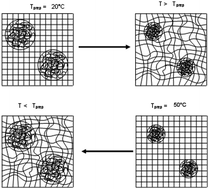The thermo-responsive behaviour of poly-(N-isopropylacrylamide) (PNiPAM) microgels embedded in covalently cross-linked non-temperature-sensitive polyacrylamide (PAam) hydrogel matrixes with different compositions was investigated by using small angle neutron scattering (SANS). The composition of the composite hydrogel was varied by (a) increasing the cross-linker and acrylamide concentration leading to strong hydrogel matrixes and (b) by increasing the microgel concentration to obtain composite gels with an internal structure. Additionally we synthesized composite hydrogels by using γ-irradiation as initiation for the polymerisation. This leads to the formation of chemical bonds between the PNiPAM microgels and the surrounding polyacrylamide matrix. Thus it is possible to synthesize hydrogels without an additional cross-linker, as well as pure particle networks. Some samples were prepared at two different temperatures, below and above the volume phase transition temperature of PNiPAM, resulting in highly swollen or totally collapsed microgels during the incorporation step. The volume phase transition of microgels is not influenced by a hydrogel matrix with high acrylamide concentration independent of the preparation temperature. However, an increased cross-linker concentration leads to a corset like constraint on microgel swelling. Microgels, which are embedded in the collapsed state (at 50 °C), are not able to swell upon cooling, whereas microgels embedded in the swollen state can collapse upon heating. For samples with an increased microgel concentration, the close microgel packing was disturbed by the formation of the polyacrylamide matrix. The hydrogel matrix squeezes the microgels together and leads to partial aggregation. The experiments demonstrate how composite hydrogels with stimuli-sensitive heterogeneities can be prepared such that the full responsiveness of the embedded microgels is retained while the macroscopic dimensions of the gel are not affected by the volume phase transition of the microgels.

You have access to this article
 Please wait while we load your content...
Something went wrong. Try again?
Please wait while we load your content...
Something went wrong. Try again?


 Please wait while we load your content...
Please wait while we load your content...